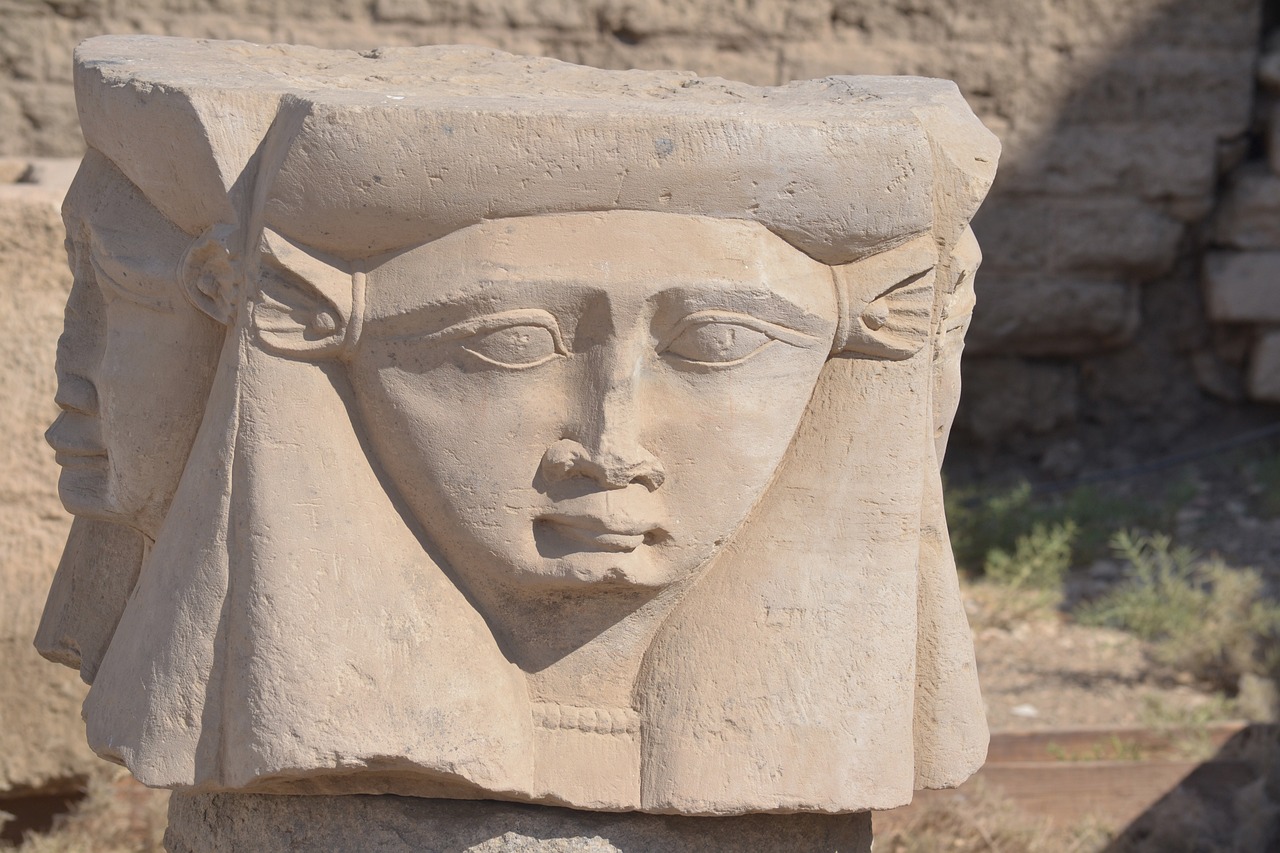Hathor, an ancient Egyptian goddess known as ‘the great one of many names,’ was cherished for her multifaceted nature and diverse roles.
Often portrayed as a cow or a woman adorned with cow’s ears, Hathor embodied maternal care and nurturing qualities. Her associations extended to the heavens, as well as love, beauty, music, dance, fertility, and happiness.
Overview of Hathor’s Significance
Identity and Early References
Evidence of Hathor’s worship dates back nearly 5,000 years, influencing various aspects of Egyptian existence, including love, childbirth, music, and even the afterlife. Her numerous names and titles reflect her extensive significance. It is suggested that Hathor may have been worshiped even in the pre-dynastic era.
In her role as a sky deity, Hathor was potentially viewed as the mother or partner of either Horus, the sky god, or Ra, the sun god—both intrinsic to the lineage of the Pharaohs. This placed her in a position of symbolic motherhood.
Dual Nature
Hathor’s personality encompassed two distinct aspects; she was tender and nurturing as the goddess of motherhood and joy, yet fierce and protective of Ra while guiding souls to the afterlife. This duality was an essential aspect of her representation, embodying the complexity of femininity as the ancient Egyptians understood it. Artistic depictions frequently featured Hathor with a cow’s head, or alternatively, as a lioness or cobra, indicating her diverse roles.
The Origins of Hathor
Cattle Associations
Art from predynastic Egypt frequently illustrated goddesses with bovine features, reflecting the culture’s reverence for cattle as symbols of nurturing and sustenance. Early artifacts, like the Gerzeh Palette, depict a cow’s head encircled by stars, suggesting a divine connection between cattle and the cosmos, foreshadowing Hathor’s later significance.
Hathor’s prominence surfaced during the Fourth Dynasty, where she superseded other goddess figures, such as Bat, particularly as the patron deity of cities like Dendera in Upper Egypt. Notably, her iconography delineated her from earlier depictions, featuring outwardly curved horns.
Name Interpretation
The name ‘Hathor’ translates to ‘the house of Horus,’ a term that scholars have offered various interpretations for. Some posit that this reflects her role as Horus’s mother, interpreting ‘house’ as a metaphorical ‘womb.’ Her hieroglyphic representation—a square enclosing a falcon—evokes associations with her status as either Horus’s consort or the sky goddess.
Titles and Epithets
Numerous titles were attributed to Hathor, highlighting her expansive domain:
- The Primeval Goddess
- Lady of the Holy Country
- The Distant Goddess
- Hand of God
These varied titles reveal her roles as a nurturing figure and her connections with sexuality and dance—her meanings intertwined and reflective of the ancient Egyptians’ perspectives.
Artistic Representation
Hathor’s image varied across different artistic forms. She was traditionally depicted as a woman in vibrant colors, often clad in a dress and wearing a headdress with horns and a solar disk. Iconography depicting her as a cow nursing a king symbolizes fertility and nurturing.
In more aggressive portrayals, Hathor assumed the forms of a lioness or cobra, while her gentler aspect was illustrated through the sycamore tree, symbolizing life and sustenance. The unique style of representing her, particularly in her cow form, is noteworthy, emphasizing her integral presence in temple architecture.
Influence and Transformation
Hathor’s significance evolved over time; as Isis began to gain prominence, her attributes started to blend with those of Hathor, leading to instances of ambiguity in their representations.
Mythological Background
Hathor’s various roles enriched Egyptian mythology, and her significance persisted despite the rise of other deities. Legends of her origins diverge, with some narratives representing her as the embodiment of the Milky Way and nurturing the cosmos through her cow form. Conversely, other tales portray her as a fierce retaliator unleashed by Ra, illustrating how myths served dual purposes in reinforcing cultural values.
The Osiris Connection
Although Isis was central to the Osiris myth, Hathor played a vital role when she appeared to bolster Osiris’s revival during the trial of Horus against Set.
Roles and Domains
Hathor’s diverse roles revealed her integral influence across a multitude of human experiences.
Sky Deity
Egyptians envisioned the sky as a liquid body from which gods were birthed. Displayed as a cow in this context, Hathor was seen as the mistress of the sky, reinforcing her image as a nurturing force for the cosmos.
Goddess of the Sun
Hathor was linked in various ways to solar deities, her relationship dynamic with Ra often shifting—either as his partner or offspring. Central to the cycle of life and rebirth, her associations included delivering and nurturing the sun each morning.
Music and Joy
Music and dance held significant value in Egyptian culture. Festivals dedicated to Hathor incorporated music, dancing, and revelry, rooted in her myth of being calmed by intoxicating brews during moments of destruction.
Goddess of Beauty, Love, and Motherhood
Hathor’s essence as the mother figure extended into domains of love and beauty. Various myths depicted her intimately involved in concepts of creation, drawing connections to procreation and aesthetic appeal.
Goddess of Fate
The goddess was also linked to fate, with her appearances in narratives predicting the outcomes of central characters’ lives, illustrating the ancient belief in inevitable destiny.
Cultural Impact
Spanning beyond Egypt, Hathor’s worship extended to adjacent regions, establishing her as a formidable figure in local mythology.
Temples and Worship
Hathor’s temples, particularly in Dendera, remain amongst the best-preserved structures in Egypt. She was honored extensively, with both men and women participating in her worship, though the role of female priests diminished over time.
Festivals
Festivals honoring Hathor encapsulated the essence of joy and merriment, particularly during events celebrating life and harvest. The Festival of Drunkenness and the Beautiful Festival of the Valley showcased this joyous reverence.
Royal Connections
Hathor’s influence was felt within royal circles, where links to the divine legitimized power. She was similarly associated with pharaohs and queens alike, solidifying her status within the court.
A complex deity, Hathor’s dual nature and extensive roles enshrined her as an emblematic figure throughout ancient Egyptian history.



